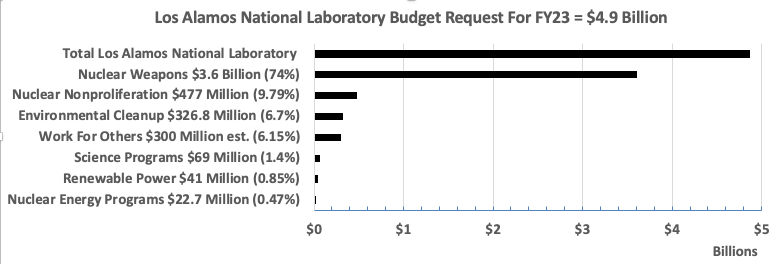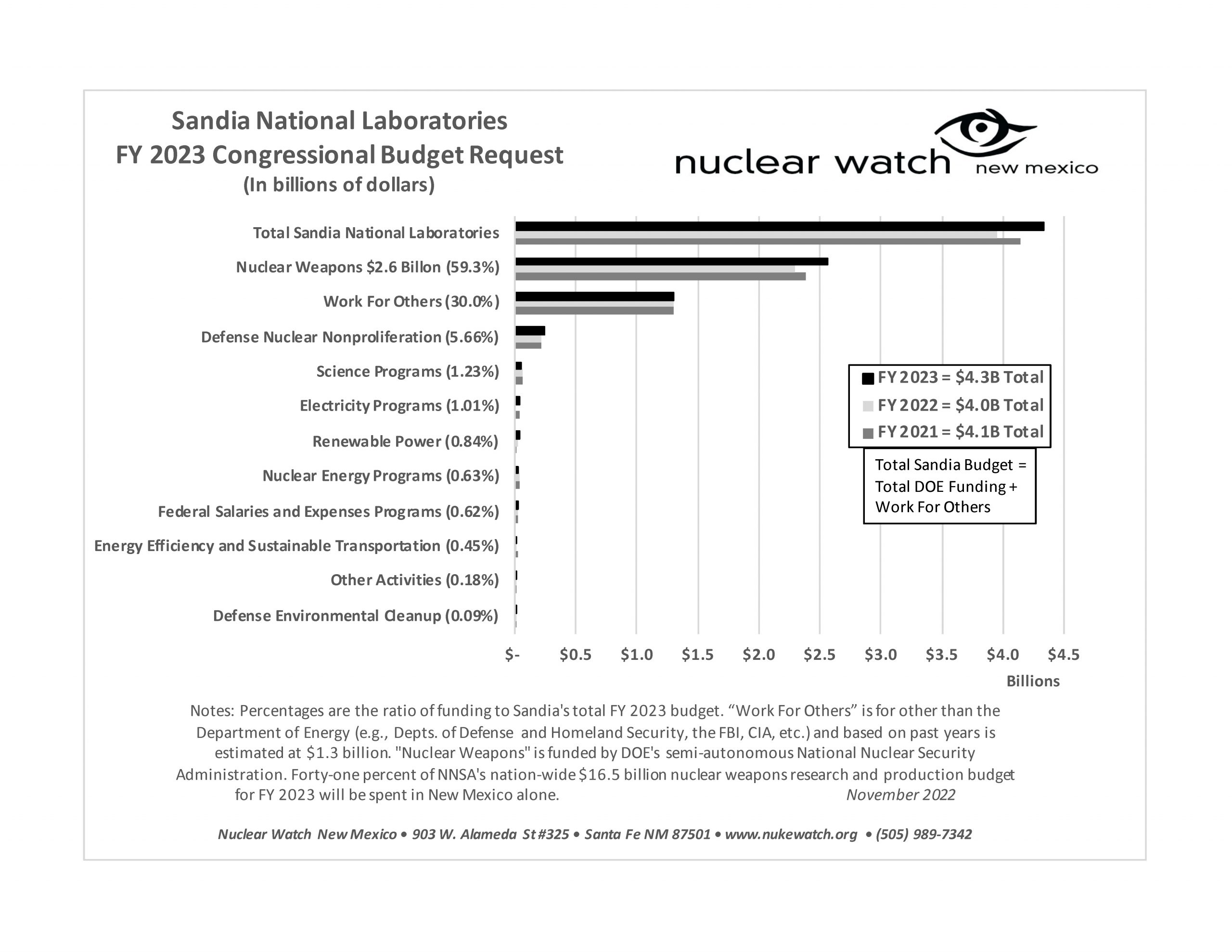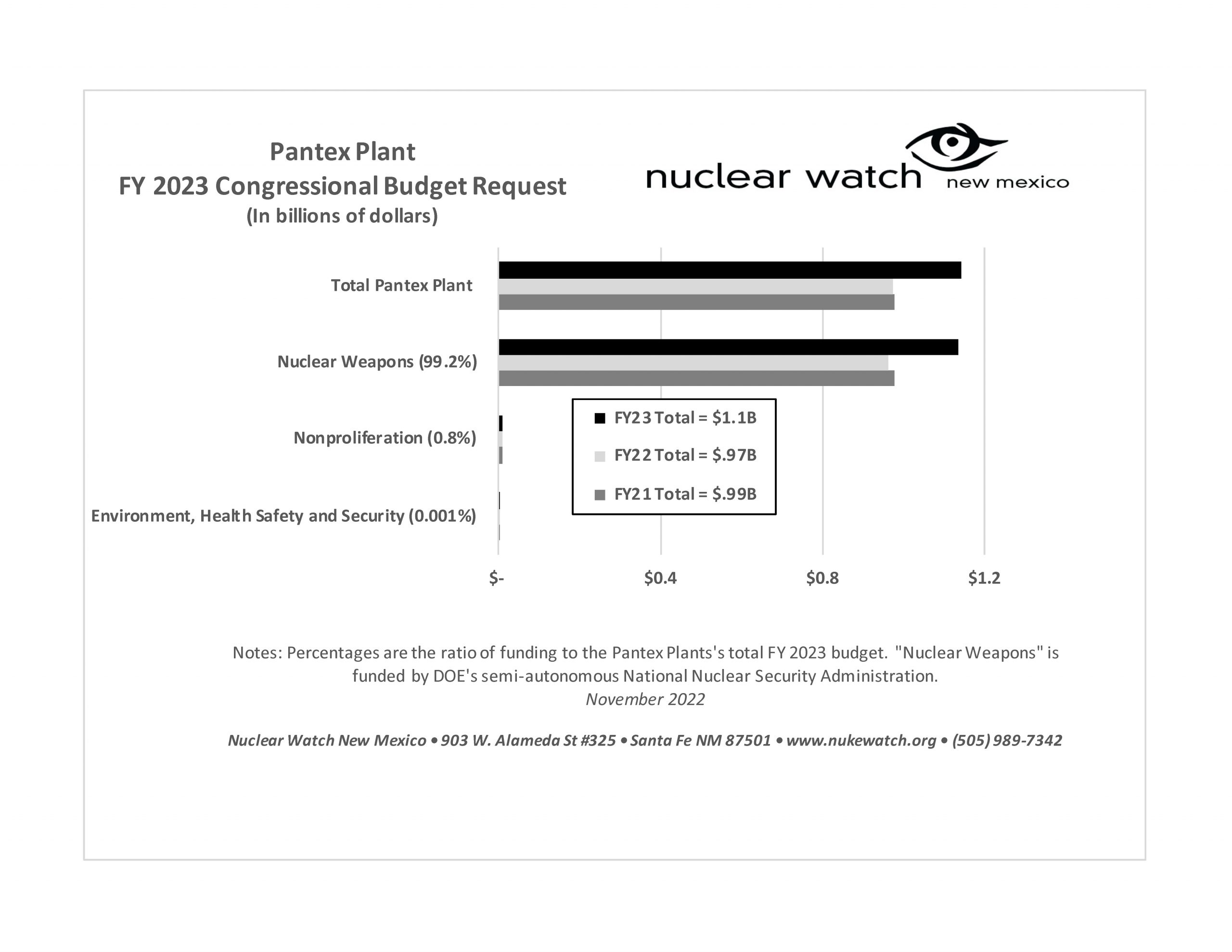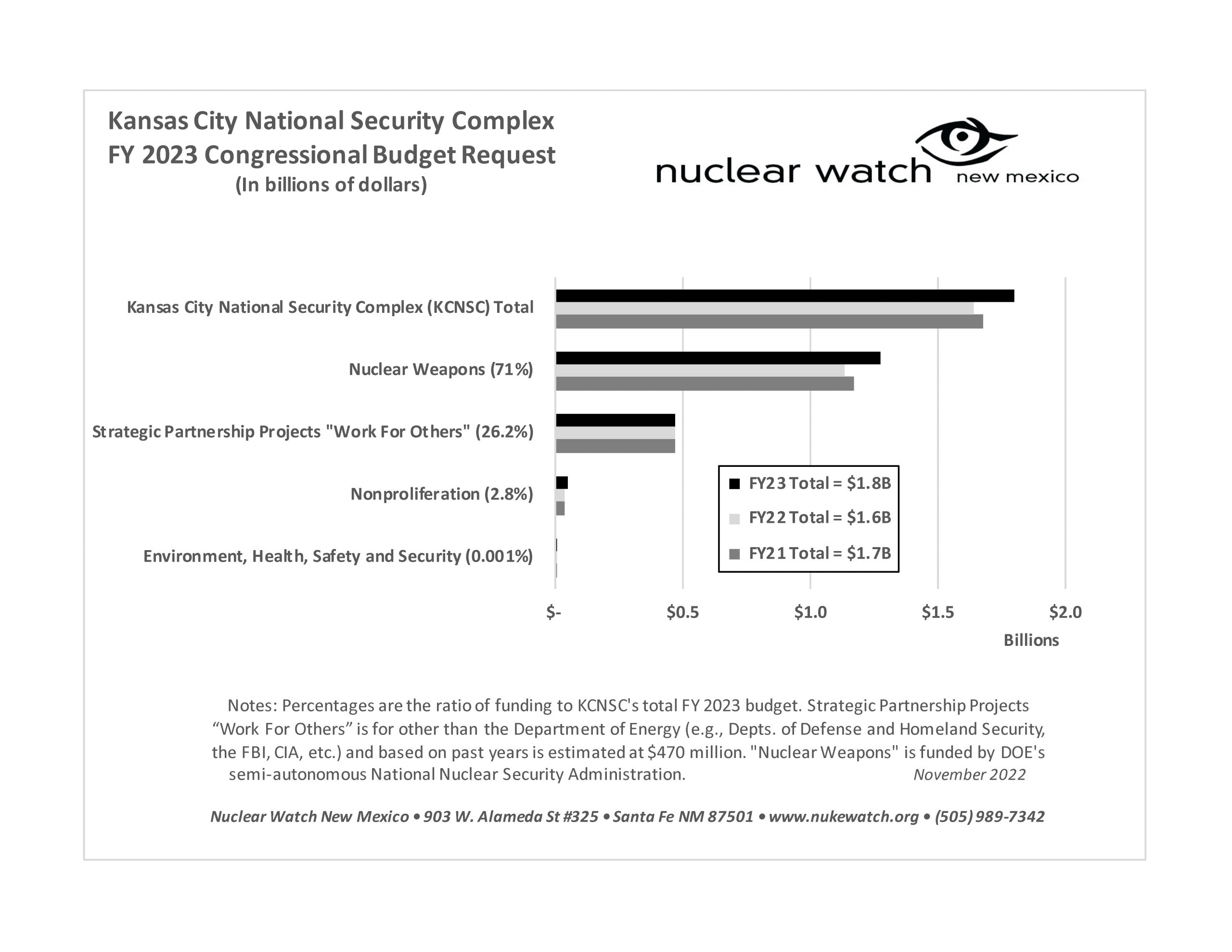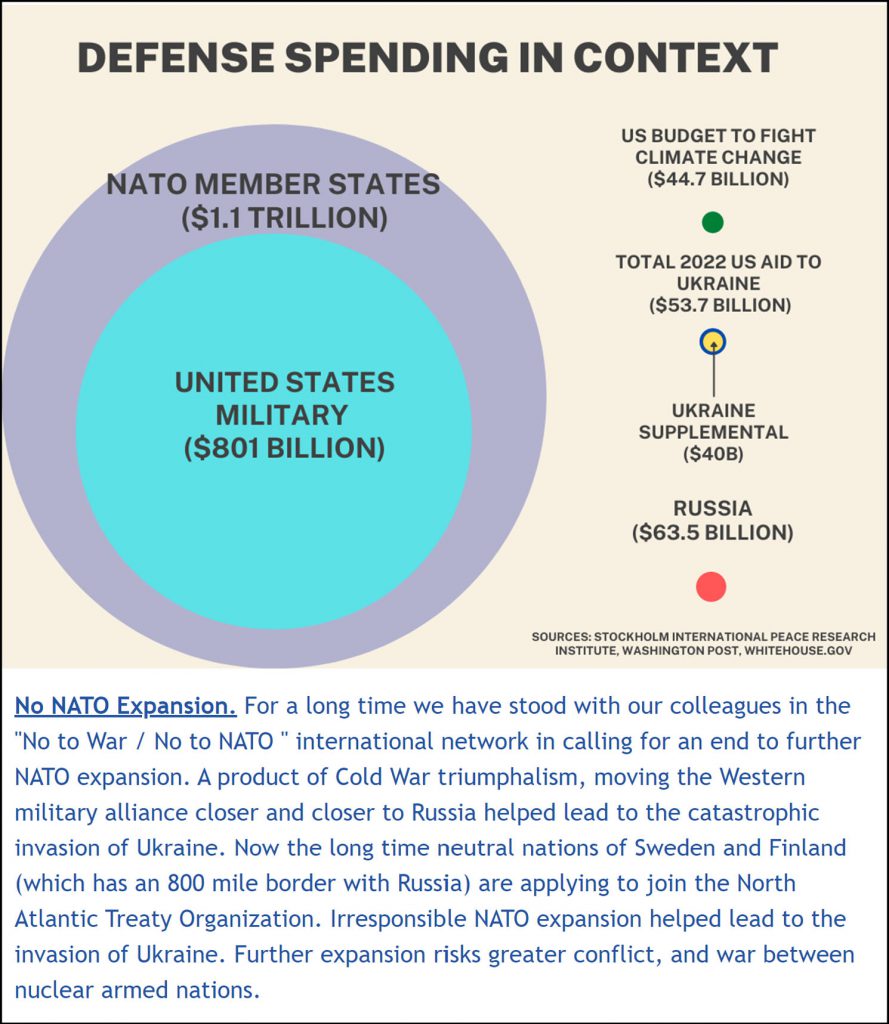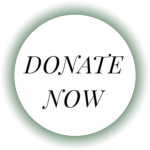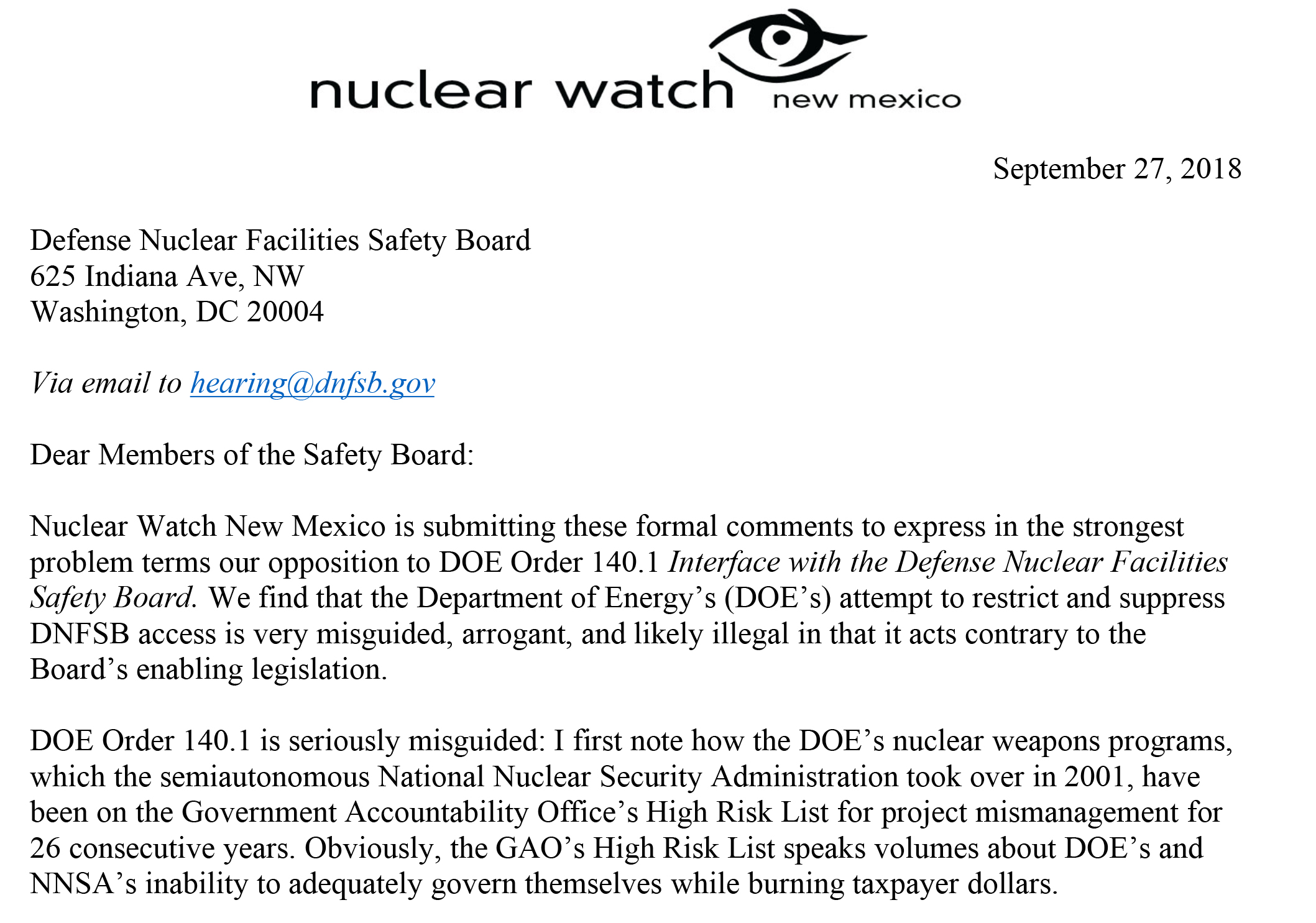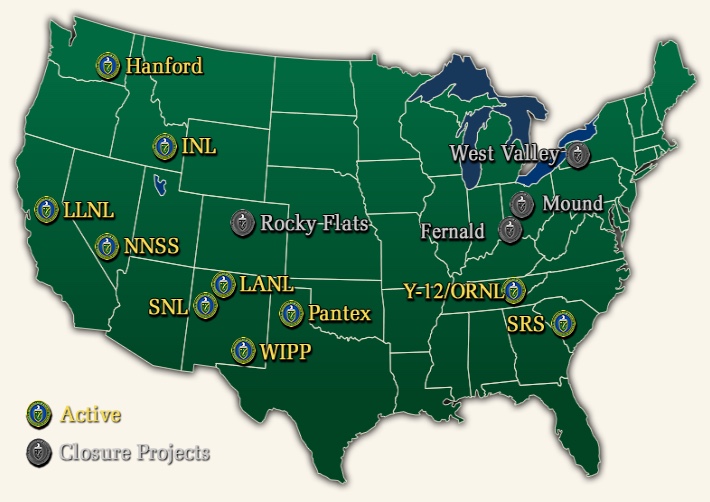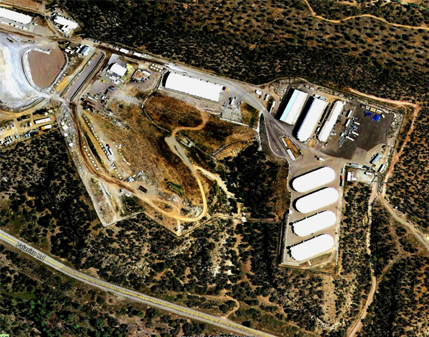QUOTE OF THE WEEK
Nothing Found
It seems we can’t find what you’re looking for. Perhaps searching can help.
LANL’s Central Mission: Los Alamos Lab officials have recently claimed that LANL has moved away from primarily nuclear weapons to “national security”, but what truly remains as the Labs central mission? Here’s the answer from one of its own documents:
LANL’s “Central Mission”- Presented at: RPI Nuclear Data 2011 Symposium for Criticality Safety and Reactor Applications (PDF) 4/27/11
Banner displaying “Nuclear Weapons Are Now Illegal” at the entrance in front of the Los Alamos National Lab to celebrate the Entry Into Force of the Nuclear Weapon Ban Treaty on January 22, 2021
Nothing Found
It seems we can’t find what you’re looking for. Perhaps searching can help.
Follow the Money!
Map of “Nuclear New Mexico”
Nuclear Watch Interactive Map – U.S. Nuclear Weapons Complex
In 1985, US President Ronald Reagan and and Russian President Mikhail Gorbachev declared that “a nuclear war cannot be won and must never be fought.”

Waste Lands: America’s Forgotten Nuclear Legacy
The Wall St. Journal has compiled a searchable database of contaminated sites across the US. (view)
Related WSJ report: https://www.wsj.com
2022 BLOG POSTS
Nothing Found
It seems we can’t find what you’re looking for. Perhaps searching can help.
New & Updated
George Shultz: We Must Preserve This Nuclear Treaty
BY GEORGE P. SHULTZ nytimes.com
Mr. Shultz was a secretary of state in the Reagan administration.
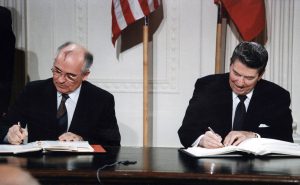
Nuclear weapons are a threat to the world. Any large-scale nuclear exchange would have globally catastrophic consequences. Conscious of this reality, President Ronald Reagan and Mikhail Gorbachev, the leader of the Soviet Union, worked in the 1980s to reduce the number of nuclear weapons, with the ultimate goal of getting rid of them.
The Intermediate-Range Nuclear Forces Treaty, signed in 1987, was a major step toward this goal, eliminating a large class of nuclear weapons that were viewed as particularly destabilizing. The treaty is still in force, although both the Obama and Trump administrations have said that Russia is in violation. Whatever the case, we need to preserve the agreement rather than abandon it, as President Trump has threatened to do.
A September 11th Catastrophe You’ve Probably Never Heard About
In 1957, America narrowly averted a nuclear meltdown at the Rocky Flats plant in Colorado. A new book explores how close we all came to disaster.
ANDREW COHEN | theatlantic.com
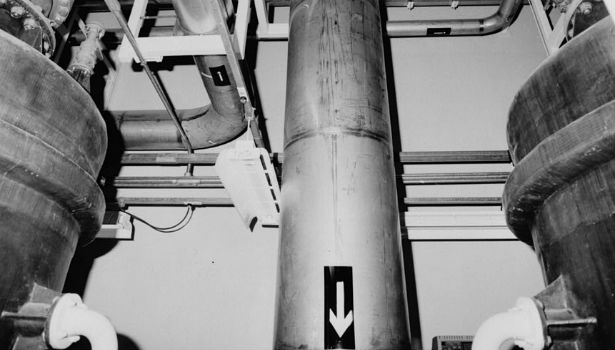
Watchdog groups oppose DOE attempt to limit oversight, endanger safety at nuclear facilities
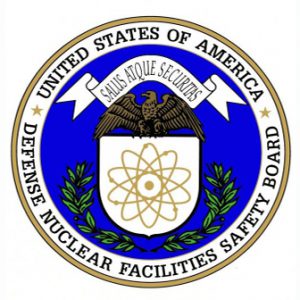
Alliance for Nuclear Accountability
CONTACTS:
Kathy Crandall Robinson (Washington, DC): 202 577 9875
Joni Arends (New Mexico): 505 986 1973
Tom Carpenter (Washington state): 206 419 5829
Tom Clements (South Carolina): 803 834 3084
Jay Coghlan (New Mexico): 505 989 7342
Don Hancock (New Mexico): 505 262 1862
Ralph Hutchison (Tennessee): 865 776 5050
Marylia Kelley (California): 925 443 7148
Watchdog groups from across the nuclear weapons complex are pushing back against a new Department of Energy order that severely constrains the oversight capacity of the Defense Nuclear Facilities Safety Board [DNFSB] at an August 28 hearing in Washington, DC. Kathy Crandall Robinson will speak at the hearing.
Members of the Alliance for Nuclear Accountability, a national network of organizations that addresses nuclear weapons production and waste cleanup issues, hail the work of the DNFSB as a critical guard against DOE and National Nuclear Security Administration efforts to cut corners on safety.
“The Safety Board works outside of the media spotlight,” said Tom Clements, Director of Savannah River Site Watch in Columbia, South Carolina.
“Its value to the public is immeasurable. DNFSB frequently provides information about SRS operations which DOE fails to communicate. The role of the Safety Board should be expanded, not curtailed.”
Marylia Kelley, Executive Director of Tri-Valley CAREs in Livermore, California, said, “The DNFSB is absolutely vital to worker and public safety. I have spent 35 years monitoring Livermore Lab. I can tell you that workers and community members rely on the Safety Board to do its job—every day!”
DOE MUST RESTORE DEFENSE NUCLEAR FACILITIES SAFETY BOARD ACCESS TO INFORMATION, NUCLEAR SECURITY FACILITIES, AND PERSONNEL
DOE MUST RESTORE DEFENSE NUCLEAR FACILITIES SAFETY BOARD ACCESS TO INFORMATION, NUCLEAR SECURITY FACILITIES, AND PERSONNEL
On May 14, 2018, the Department of Energy (DOE) Deputy Secretary approved DOE Order 140.1Interface with the Defense Nuclear Facilities Safety Board,which limits release of information, limits the DNFSB’s access to nuclear security sites, and personnel. The impacts are already being felt by Congress, the Board, DOE contractors and workers, and in communities located near some of the most dangerous nuclear facilities across the nation.
What you can do –
The Board is holding a public hearing on Tuesday, August 28, 2018, from 9 am to 12:30 pm Eastern Day- light Time. It will be live streamed and the link will be available on the day of the hearing.
Public comments will be accepted until September 28, 2018.
Read the Alliance for Nuclear Accountability Fact Sheet here.
Citizens Oppose Plans For New Mexico Nuclear Waste Dump
Citizens Oppose New Mexico Nuke Dump
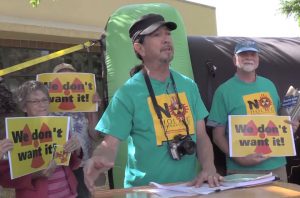
“We Don’t Want It!”
The Nuclear Waste Policy Act of 2018, HR 3053, known as the Shimkus Bill, has passed the House on its way to the Senate.
It calls for restarting the failed Yucca Mountain Project in Nevada, and establishing a system of Consolidated Interim Storage (CIS) sites for radioactive waste around the country until Yucca is operational.
First on the list of possible ‘temporary’ CIS dumps is a site proposed by Holtec International and the local Eddy-Lea Alliance just outside Hobbs, New Mexico. Its just over the border from Andrews, Co., Texas – where another high level nuke waste dump is also proposed.
Proponents tout it as an economic boon. Opponents see as it a public health and environmental disaster.
Planned to eventually hold more metric tons of waste than Yucca itself will be designed for, the Hobbs site could well become America’s de facto national dump site, if Yucca never gets built.
At a recent series of Nuclear Regulatory Commission community meetings on the proposed site, opposition was strong from many of New Mexico and Texas public sectors.
A press conference by local citizens laid out their views.
“We Don’t Want It!” Halt Holtec campaign continues. Opposition to proposed nuke dump is strong and growing.
Katzman Tells Utilities Board RDX Never Detected In County Water Supply Wells
Danny Katzman gave his punchline first Tuesday evening at the Nov. 20 Los Alamos County Board of Public Utilities meeting where he gave a presentation on Royal Demolition Explosive (RDX) contamination from Los Alamos National Laboratory. Katzman is the Technical Programs Manager for N3B, the Lab’s legacy waste cleanup contractor.
By: MAIRE O’NEILL | losalamosreporter.com November 24, 2018
“RDX has never been detected in the County’s water supply wells. It’s nowhere near the County water supply wells and it’s every intent of the Department of Energy and N3B to ensure that never becomes the case,” Katzman said.
In introducing Katzman, Utilities Manager Tim Glasco said DOE revealed in a meeting with the County Council as part of an overall presentation on groundwater protection and other environmental activities going on at LANL that they were following an RDX contamination vent out at the Lab. He said there was some citizen concern and concern by some County Council members about the extent of that contamination and whether or not it was a threat, specifically to the County’s drinking water wells. Glasco said he met with DOE Environmental Management and N3B and that it became apparent that “it’s a fairly complex situation out there” so he requested that N3B make a presentation to the board.
Principles for Safe Management and Geological Isolation of Irradiated Nuclear Fuel
Summary: The environmental risks posed by irradiated fuel are extreme: As observed by the U.S. Court of Appeals, it has “the capacity to outlast human civilization as we know it and the potential to devastate public health and the environment.” Nuclear Energy Inst., Inc. v. Envtl. Prot. Agency, 373 F.3d 1251 (D.C. Cir. 2004).If irradiated fuel is dispersed into the environment, its radionuclides are sufficiently toxic to cause irreparable contamination of large areas of land and entire river and lake systems and coastal ecosystems.
The risk of nuclear weapons proliferation posed by irradiated fuel is also significant. Each metric ton of spent fuel typically contains more than one Nagasaki-bomb equivalent of plutonium and, as of 2016, well over 70,000 metric tons had already be been created in the United States by the commercial nuclear power reactors. Spent fuel, storage and/or disposal may pose a risk of theft if it is stored or disposed of in a manner that would allow access in a few hundred years when the fission product radiation barrier would have declined to low levels.
Clean Up Area G: Hundreds of Jobs Could Be Created that Protect the Environment
Summary
New Mexicans should push their politicians to vigorously lobby for comprehensive cleanup at the Los Alamos National Laboratory (LANL). Unlike nuclear weapons programs, cleanup would be a win-win that permanently protects the environment while creating hundreds of high paying jobs. Continue reading
Federal District Court Allows Lawsuit to Proceed Against DOE/LANS Potential Penalties Exceed $300,000,000
For Immediate Release
New Mexico Environmental Law Center
Nuclear Watch New Mexico – Santa Fe, NM
A United States District Court judge has ruled that a lawsuit filed by Nuclear Watch New Mexico (NukeWatch) can move forward. The lawsuit is based on thirteen (13) violations of corrective actions Los Alamos National Security, LLC (LANS) and the Department of Energy (DOE) failed to complete under a 2005 Consent Order governing cleanup that the New Mexico Environment Department (NMED) fought for under former Governor Bill Richardson.
Fines for failure to complete the corrective tasks are $37,000 per violation per day. Violations for failing to complete the tasks started as early as June 2014 and now total well over $300 million.
The judge in allowing the lawsuit on civil penalties to move forward stated that DOE/LANS had failed to show in their legal and factual analysis that violations were unlikely to recur.
Jon Block, representing NukeWatch as a staff attorney at the New Mexico Environmental Law Center, said “We are gratified that the Court is allowing the lawsuit on civil penalties to move forward.”
In 2002, the NMED determined that decades of contamination at Los Alamos National Laboratory constituted an “imminent and substantial endangerment to health and the environment” and sought to compel cleanup at the Lab. DOE/LANS counter-sued, and in 2005 the parties agreed to a Consent Order specifying that DOE/LANS would characterize the extent and nature of the contamination, assess alternatives for effective cleanup of the contamination, and implement cleanup. Gov. Martinez came into office in 2011, after which DOE/LANS compliance with the Consent Order effectively stopped.
NukeWatch filed its original complaint in May 2016, followed by an amended complaint in July 2016. That was in response to a June 2016 announcement by NMED and DOE/LANS that they had entered into a new Consent Order that rendered the 2005 Consent Order invalid.
The judge did grant DOE/LANS and NMED’s motions to dismiss that part of NukeWatch’s complaint asking for declaratory and injunctive relief (in general seeking to have the 2016 Consent Order declared invalid). However, the judge specifically noted that the revised 2016 Consent Order replaced enforceable goals in the 2005 Order with unenforceable goals.
Jay Coghlan, NukeWatch director, commented “Susana Martinez’ administration shamefully gave away the store to the Los Alamos Lab, forgiving hundreds of millions of dollars in potential penalties for clear violations of an enforceable cleanup order, at the very time when New Mexico was facing a serious budget crisis. We are very pleased that the issue of penalties can now go forward in court, which should bring some accountability toward achieving comprehensive Lab cleanup that would produce hundreds of high-paying jobs.”
See NukeWatch’s Amended Complaint here
See Judge Judith Herrera’s decision here
Contacts:
Jay Coghlan: Nuclear Watch New Mexico
989.7342
Jon Block, Staff Attorney: New Mexico Environmental Law Center
505.989.9022
New Contractors Selected For Expanded Nuclear Weapons Production at Los Alamos
Santa Fe, NM – Today the Department of Energy’s National Nuclear Security Administration (NNSA) announced its choice for the new management and operating contract for the Los Alamos National Laboratory (LANL).
The new contractor, Triad National Security, LLC, is a limited liability company consisting of the Battelle Memorial Institute, the University of California and Texas A&M University. All three are non-profits, and it is unclear how this will affect New Mexico gross receipts taxes.
Battelle claims to be the world’s largest non-profit technology research and development organization, and manages a number of labs including the Lawrence Livermore and Idaho National Laboratories. Texas A&M was founded in 1876 as the state’s first public institution of higher learning and has the largest nuclear engineering program in the country. DOE Secretary Rick Perry is an avid A&M alumnus.
The new contract includes a five-year base time with five one-year options, for a total of 10 years if all options are exercised. The estimated value of the contract is $2.5 billion annually.
The University of California (UC) ran the Lab from its beginning in 1943 until June 2006, when Los Alamos National Security, LLC (LANS), composed of the University of California (UC), Bechtel, AECOM and BWX Technologies, Inc., took over. That contract had a ten-year base period with ten one-year options, for a total of 20 years if all options were exercised. But LANS was terminated with nine years left of possible options. This was primarily due to LANS improperly preparing a barrel of radioactive wastes that ruptured, closing the Waste Isolation Pilot Plant for nearly three years. NNSA did not clarify why it is now issuing a shorter contract.
This change in contract follows a May 10, 2018 announcement by NNSA that production of plutonium pits, the fissile cores of nuclear weapons, will be expanded to at least 30 pits per year at LANL, and an additional 50 pits per year at the Savannah River Site. The Los Alamos Lab is the birthplace of nuclear weapons, and it is tying its future to increased nuclear weapons production, with the active support of the New Mexico congressional delegation. The Lab proposed, but failed to convince NNSA, to produce all 80 plutonium pits per year. LANL’s core research, testing and production programs for nuclear weapons now comprise 70% of its ~$2.5 billion annual budget, while much of the Lab’s remaining budget indirectly supports those programs.
Lisa E. Gordon-Hagerty, the new NNSA Administrator, testified during her confirmation hearing that expanded plutonium pit production is her number one priority. However, expanded production is NOT needed to maintain the safety and reliability of the existing nuclear weapons stockpile. In fact, no pit production for the existing nuclear weapons stockpile has been scheduled since 2011, and none is scheduled for the future. Up to 15,000 “excess” pits and another 5,000 in “strategic reserve” are already stored at DOE’s Pantex Plant near Amarillo, TX. In 2006 independent experts found that pits last a least a century (they currently average 40 years old). A 2012 follow-on study by the Livermore Lab found that the “graceful aging of plutonium also reduces the immediate need for a modern high-capacity manufacturing facility to replace pits in the stockpile.”
Future pit production is for speculative future new designs being pushed by the nuclear weapons labs, so-called Interoperable Warheads for both land- and sub-launched missiles that the Navy does not want. Moreover, future pits will NOT be exact replicas of existing pits. This could have serious potential consequences because heavily modified plutonium pits cannot be full-scale tested, or alternatively could prompt the U.S. to return to nuclear weapons testing, which would have severe international proliferation consequences.
Jay Coghlan, Nuclear Watch Director, commented, “Regardless of who runs the Lab, LANL will decrease mission diversification and increase nuclear weapons production, while holding cleanup flat at a tenth of its weapons budget. New Mexico been a nuclear weapons colony since WWII, and adding Battelle, Texas A&M, and the University of California is just more of the same. There will be little if any added benefit for New Mexico’s citizens.”
Groups Release Key DOE Documents on Expanded Plutonium Pit Production, DOE Nuclear Weapons Plan Not Supported by Recent Congressional Actions
“Santa Fe, NM & Columbia, SC. Two key U.S. Department of Energy documents on future production of plutonium “pits” for nuclear weapons, not previously released to the public, fail to justify new and upgraded production facilities at both the Los Alamos National Laboratory (LANL) in New Mexico and the Savannah River Site (SRS) in South Carolina.”
Groups Release Key DOE Documents on Expanded Plutonium Pit Production, DOE Nuclear Weapons Plan Not Supported by Recent Congressional Actions
Santa Fe, NM & Columbia, SC – Two key U.S. Department of Energy documents on future production of plutonium “pits” for nuclear weapons, not previously released to the public, fail to justify new and upgraded production facilities at both the Los Alamos National Laboratory (LANL) in New Mexico and the Savannah River Site (SRS) in South Carolina.
The report reveals that the initial cost estimate for these new and upgraded facilities at both sites is $10 billion by 2030, and around $46 billion in total life cycle costs. Plutonium pits are the fissile cores of nuclear weapons. Cost overruns are the rule for major projects undertaken by the National Security Administration (NNSA), the semi-autonomous nuclear weapons agency within DOE, so the costs are likely to rise yet more, according to Nuclear Watch New Mexico and Savannah River Site Watch.
NNSA’s Pu Pit Production Engineering Assessment, originally marked Unclassified Controlled Nuclear Information, was finalized on April 20, 2018. The 293-page document was obtained by Nuclear Watch and is being released so that the public may be fully informed about the agency’s misguided pursuit of new plutonium pit production facilities for future new-design nuclear weapons. The new NNSA Administrator has called future plutonium pit production her highest priority. But the Engineering Assessment fails to answer the most crucial question: why are at least 80 plutonium pits per year needed to begin with?
As background, on May 10, 2018, NNSA announced in a one-page statement:
To achieve DoD’s [Department of Defense] 80 pits per year requirement by 2030, NNSA’s recommended alternative repurposes the Mixed Oxide Fuel Fabrication Facility at the Savannah River Site in South Carolina to produce plutonium pits while also maximizing pit production activities at Los Alamos National Laboratory in New Mexico. This two-prong approach – with at least 50 pits per year produced at Savannah River and at least 30 pits per year at Los Alamos – is the best way to manage the cost, schedule, and risk of such a vital undertaking.
Nuclear Watch also obtained NNSA’s 14-page Plutonium Pit Production Engineering Assessment (EA) Results. That summary document, dated May 2018, relied on the Trump Administration’s 2018 Nuclear Posture Review for claiming the need for expanded plutonium pit production. However, that high-level review failed to state any concrete justification for the alleged pit need. Moreover, Congress is balking at funding any new pit production facilities at SRS, primarily because Sen Lindsey Graham (R-SC) vociferously opposes repurposing the MOX facility, now undergoing termination, and the New Mexico congressional delegation opposes any pit production outside of the Los Alamos Lab.
The Engineering Assessment details that NNSA analyzed four pit production options, one in the Mixed Oxide (MOX) Fuel Fabrication Facility at SRS and three options at Los Alamos. NNSA chose the most expensive combination, repurposing the MOX facility and increasing pit production at LANL to 30 pits per year. Los Alamos is currently authorized to produce 20 pits per year, but has failed to achieve even that because of ongoing nuclear criticality safety issues (moreover, LANL proposed to produce all 80 pits per year, which NNSA rejected). SRS has never produced pits, raising new nuclear risks at that site and concern about new waste streams.
The Engineering Assessment makes clear that “moderate risks” in the option of repurposing the MOX plant at SRS includes any failure to quickly terminate the MOX project, due to subsequent delays in closing out the project and terminating contracts. Likewise, the report affirms a long-held concern that there is a “very high probability for incomplete construction records/as-built drawings” for the MOX project. On May 10, DOE began congressionally sanctioned termination of the bungled MOX project, but it is being opposed in last-ditch, desperate attempts by Senator Lindsey Graham and the State of South Carolina. The Engineering Assessment makes explicitly clear that terminating the MOX program is the crucial prerequisite for plutonium pit production at SRS and that “some work [on repurposing the MOX plant] can be completed during MOX closeout,” contrary to both the wishes of Congress and requirements of the National Environmental Policy Act.
Expanded plutonium pit production is NOT needed to maintain the safety and reliability of the existing nuclear weapons stockpile, according to Nuclear Watch. In fact, no pit production for the existing nuclear weapons stockpile has been scheduled since 2011, and none is scheduled for the future. Up to 15,000 “excess” pits and another 5,000 in “strategic reserve” are already stored at DOE’s Pantex Plant near Amarillo, TX. In 2006 independent experts found that pits last a least a century[i] (they currently average 40 years old). A 2012 follow-on study by the Livermore Lab found that the “graceful aging of plutonium also reduces the immediate need for a modern high-capacity manufacturing facility to replace pits in the stockpile.” [ii]
Future pit production is for speculative future new designs being pushed by the nuclear weapons labs, so-called Interoperable Warheads for both land- and sub-launched missiles that the Navy does not support.[iii] Moreover, as the Engineering Assessment makes clear, future pits will NOT be exact replicas of existing pits. This could have serious potential consequences because heavily modified plutonium pits cannot be full-scale tested, or alternatively could prompt the U.S. to return to nuclear weapons testing, which would have severe international proliferation consequences.
The Engineering Assessment also explicitly links raising the administrative limit on plutonium at LANL’s “Rad Lab” to expanded pit production. This contradicts a recent draft environmental assessment in which NNSA claimed that re-categorizing the Rad Lab as a Hazard Category-3 nuclear facility was necessary only to maintain basic analytical chemistry capabilities, while omitting any reference whatsoever to expanded plutonium pit production.
The Engineering Assessment briefly outlines what could be a major vulnerability to NNSA’s pit production plans, that is the agency’s future compliance (or not) with the National Environmental Policy Act (NEPA). The Assessment states that if “compliance is delayed, [this] extends the schedule, increases costs, and/or delays production.” Both Nuclear Watch and SRS Watch assert that the law requires that major federal proposals be subject to public review and comment before a formal decision is made. Arguably, a formal decision to raise production to 80 pits or more per year necessitates a new or supplemental nation-wide programmatic environmental impact statement (PEIS), which the new dual-site decision strongly buttresses. Follow-on site-specific NEPA documents will then be necessary, with full public participation and hearings. All of this could introduce substantial delays to NNSA’s plutonium pit production plans.
“While it’s clear that the bungled MOX project is unworkable from technical and cost perspectives and must rapidly be terminated, there is no justification to convert the abandoned facility to a nuclear bomb production plant,” said Tom Clements, director of SRS Watch. “We agree that money must now be spent closing and securing the MOX building, but not on the new, unauthorized pit mission. Spending taxpayer funds to now begin conversion of the MOX plant to pit production, as is indicated in the pit report, is premature and can’t even be considered until Congress approves the NNSA approach for new facilities and an environmental impact review with public participation takes place,” added Clements.
Jay Coghlan, Nuclear Watch Director, commented, “NNSA has already tried four times to expand plutonium pit production, only to be defeated by citizen opposition and its own cost overruns and incompetence. We realize that this fifth attempt at a new pit plant is the most serious yet, but we remain confident it too will fall apart. The enormous financial and environmental costs of new nuclear bomb factories and the fact that expanded plutonium pit production is simply not needed for the existing nuclear weapons stockpile will doom this effort. We think the American public will reject new-design nuclear weapons, which is what this expanded pit production decision is really all about.”
Notes:
NNSA’s Plutonium Pit Production Engineering Assessment (EA) Results (14 slides) is available at
NNSA’s 293-page Pu Pit Production Engineering Assessment is available at
NNSA’s Joint Statement from Ellen M. Lord and Lisa E. Gordon-Hagerty on Recapitalization of Plutonium Pit Production, May 10, 2018, is available at
[i] Pit Lifetime (JSR-06-335), the MITRE Corporation, JASON, January 27, 2007, p. 19, http://www.fas.org/irp/agency/dod/jason/pit.pdf
This pivotal study came about because at Nuclear Watch New Mexico’s request then-Senator Jeff Bingaman (D.-NM) successfully offered an amendment to the FY 2004 Defense Authorization Act requiring it.
[ii] Plutonium at 150 years, Lawrence Livermore National Laboratory, December 2012,
https://www.llnl.gov/news/plutonium-150-years
[iii] See 2012 Navy memo demonstrating its lack of support for the Interoperable Warhead at https://nukewatch.org/importantdocs/resources/Navy-Memo-W87W88.pdf
Los Alamos Cleanup
Over the last decade funding for the Los Alamos National Laboratory’s (LANL’s) nuclear weapons programs has increased by 20%. However, funding for needed cleanup has remained flat at one-tenth of the $1.9 billion requested for nuclear weapons programs in FY 2019 ($191.6 million requested for cleanup in FY 2019). Continue reading
ACTION ALERTS
Nothing Found
It seems we can’t find what you’re looking for. Perhaps searching can help.
Nothing Found
It seems we can’t find what you’re looking for. Perhaps searching can help.
Interfaith Panel Discussion on Nuclear Disarmament - August 9
Nothing Found
It seems we can’t find what you’re looking for. Perhaps searching can help.
New Nuclear Media
Nothing Found
It seems we can’t find what you’re looking for. Perhaps searching can help.




